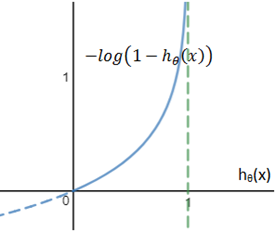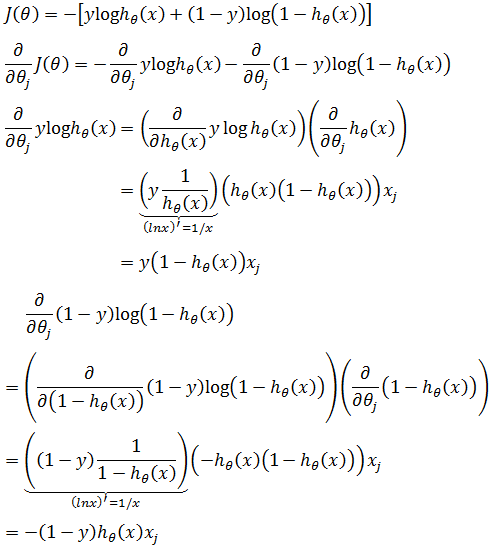ML(4)——逻辑回归
Logistic Regression虽然名字里带“回归”,但是它实际上是一种分类方法,“逻辑”是Logistic的音译,和真正的逻辑没有任何关系。
模型
线性模型
由于逻辑回归是一种分类方法,所以我们仍然以最简的二分类为例。与感知机不同,对于逻辑回归的分类结果,y ∈ {0, 1},我们需要找到最佳的hθ(x)拟合数据。
这里容易联想到线性回归。线性回归也可以用于分类,但是很多时候,尤其是二分类的时候,线性回归并不能很好地工作,因为分类不是连续的函数,其结果只能是固定的离散值。设想一下有线性回归得到的拟合曲线hθ(x),当x→∞时,有可能y→∞,这就无法对y ∈ {0, 1}进行有效解释。
对于二分类,逻辑回归的目的是找到一个函数,使得无论x取何值,都有:

满足这个式子的典型函数是sigmoid函数,也称为logistic函数:

在sigmoid函数g(z)中:

现在,将hθ(x)赋予sigmoid函数g(z)的特性:

其中:

最终,逻辑回归的模型函数:

假设给定一些输入,现在需要根据逻辑回归模型预测肿瘤是否是良性,最终得到hθ(x) = 0.8,可以用概率表述:

上式表示在当前输入下,y=1的概率是0.8,y=0的概率是0.2,因为是分类,所以判断y = 1。
需要注意的是,sigmoid函数不是样本点的分隔曲线,它表示的是逻辑回归的测结果;θTx才是分隔曲线,它将样本点分为θTx ≥ 0和θTx < 0两部分:

分隔曲线

Sigmoid函数,最终模型
由此看来,逻辑回归的线性模型同样是找到最佳的θ,使两类样本点分离,这就在很大程度上和感知机相似。
多项式模型
直观地看,线性模型的决策边界就是将两类样本点分离开的分隔曲线,我们之前已经多次接触过,只是没有给它起一个专业的名字。假设在一个模型中,hθ(x) = g(θ0 + θ1x1 + θ2x2) = g(-3 + x1 + x2),那么决策边界就是 -3 + x1 + x2 = 0:

很多时候,直线并不能很好地作为决策边界,如下图所示:

此时需要使用多项式模型添加更多的特征:


这相当于添加了两个新的特征:

深入了解不同函数的特征有助于选择正确的模型。添加的特征越多,曲线越复杂,对训练样本的拟合度越高,同时也更容易导致过拟合而丧失泛化性:

关于过拟合及其处理,可参考《ML(附录3)——数据拟合和正则化》。
多分类
我们已经知道了二分类的模型,然而实际问题中往往不只是二分类,那么逻辑回归如何处理多分类呢?
一种可行的方法就是化繁为简,将多分类转换为二分类:

如上图所示,三分类转换为三个二分类,其中上标表示分类的类别:

对于输入x,其预测结果是所有hθ(x)中值最大的一个。对于最后的预测结论,以上面的三分类为例,如果输入一个标签为2的特征集,对于hθ(0)(x) 来说,hθ(0)(x) < 0.5:

对于hθ(1)(x) 来说,hθ(1)(x) < 0.5:

对于hθ(3)(x) 来说,hθ(3)(x) ≥ 0.5:

因此,对于输入x,其预测结果是所有hθ(x)中值最大的一个。至于每个样本标签值是多少,无所谓了,在训练每个hθ(i)(x)前,都需要把y(i) 转换为1,其余转换为0。
在上面的图组中也可以看出,对于有k个标签的多分类,需要训练k个不同的逻辑回归模型。
学习策略
在感知机中,模型函数使用了sign,由于sign是阶跃函数,不易优化,所以为了求得损失函数,我们使用函数间隔进行了一系列转换。对于逻辑回归,由于函数本身是连续曲线,所以不会存在这样的问题,其J(θ)使用对数损失函数。对数损失函数的原型:

将其用在逻辑回归上:

这里的对数是以e为底的对数,即:

注意,0 < hθ(x) < 1。上图是y = 1时的costfunction,可以看到,当hθ(x)→1时,Cost(hθ(x), y)→0;当hθ(x)→0时,Cost(hθ(x),y)→∞。也就是说当分类是1时,sigmoid的值越接近于1,损失值越小;sigmoid的值越接近于0,损失值越大。损失值越大,分类点越接近决策面,其分类越模糊。与此类似,下图是 y = 0时的cost function:

Cost function可以把y = 1和y=1两种情况合并到一起:

理解这种形式需要再次将y分开:

最后得到J(θ)的最终形式:

注意,这里hθ(x)是sigmoid函数:

如果写成矩阵的形式:

上式中,hθ(x)的操作对应矩阵中的每个元素,1-Y,log hθ(x)也一样,可参照后文的代码实现来理解。
算法
与之前的算法一样,我们的目的是找到最佳的θ使得J(θ)最小化,将求解θ转换为最优化问题,即:

梯度下降
梯度下降是一个适用范围很广的方法,这里同样可以使用梯度下降求解θ:

关于梯度下降的更多内容可参考《ML(附录1)——梯度下降》。
在对J(θ)求偏导时先做一些准备工作,计算sigmoid函数的导数(关于偏导和一元函数的导数,可参考《多变量微积分》和《单变量微积分》的相关章节):

现在计算m=1时J(θ)的偏导,此时可以删除上标:


推广到m个样本:

在《机器学习实战》中提到对极大似然数使用梯度上升求最大值,最后得到:

这和对损失函数采用梯度下降求最小值是一样的,因为损失函数使用了似然数的负数形式,Cost(X, Y) = -logP(Y|X),所以对-logP(Y|X)梯度下降和对+logP(Y|X)梯度上升将得到同样的结果。
对于多项式模型,需要预先添加特征,使得每个θj都有唯一的xj对应:

如果用矩阵表示:

在此基础上使用L2正则化(关于正则化,可参考《ML(附录3)——过拟合与欠拟合》):

代码实现
ex2data1.txt:

1 34.62365962451697,78.0246928153624,0 2 30.28671076822607,43.89499752400101,0 3 35.84740876993872,72.90219802708364,0 4 60.18259938620976,86.30855209546826,1 5 79.0327360507101,75.3443764369103,1 6 45.08327747668339,56.3163717815305,0 7 61.10666453684766,96.51142588489624,1 8 75.02474556738889,46.55401354116538,1 9 76.09878670226257,87.42056971926803,1 10 84.43281996120035,43.53339331072109,1 11 95.86155507093572,38.22527805795094,0 12 75.01365838958247,30.60326323428011,0 13 82.30705337399482,76.48196330235604,1 14 69.36458875970939,97.71869196188608,1 15 39.53833914367223,76.03681085115882,0 16 53.9710521485623,89.20735013750205,1 17 69.07014406283025,52.74046973016765,1 18 67.94685547711617,46.67857410673128,0 19 70.66150955499435,92.92713789364831,1 20 76.97878372747498,47.57596364975532,1 21 67.37202754570876,42.83843832029179,0 22 89.67677575072079,65.79936592745237,1 23 50.534788289883,48.85581152764205,0 24 34.21206097786789,44.20952859866288,0 25 77.9240914545704,68.9723599933059,1 26 62.27101367004632,69.95445795447587,1 27 80.1901807509566,44.82162893218353,1 28 93.114388797442,38.80067033713209,0 29 61.83020602312595,50.25610789244621,0 30 38.78580379679423,64.99568095539578,0 31 61.379289447425,72.80788731317097,1 32 85.40451939411645,57.05198397627122,1 33 52.10797973193984,63.12762376881715,0 34 52.04540476831827,69.43286012045222,1 35 40.23689373545111,71.16774802184875,0 36 54.63510555424817,52.21388588061123,0 37 33.91550010906887,98.86943574220611,0 38 64.17698887494485,80.90806058670817,1 39 74.78925295941542,41.57341522824434,0 40 34.1836400264419,75.2377203360134,0 41 83.90239366249155,56.30804621605327,1 42 51.54772026906181,46.85629026349976,0 43 94.44336776917852,65.56892160559052,1 44 82.36875375713919,40.61825515970618,0 45 51.04775177128865,45.82270145776001,0 46 62.22267576120188,52.06099194836679,0 47 77.19303492601364,70.45820000180959,1 48 97.77159928000232,86.7278223300282,1 49 62.07306379667647,96.76882412413983,1 50 91.56497449807442,88.69629254546599,1 51 79.94481794066932,74.16311935043758,1 52 99.2725269292572,60.99903099844988,1 53 90.54671411399852,43.39060180650027,1 54 34.52451385320009,60.39634245837173,0 55 50.2864961189907,49.80453881323059,0 56 49.58667721632031,59.80895099453265,0 57 97.64563396007767,68.86157272420604,1 58 32.57720016809309,95.59854761387875,0 59 74.24869136721598,69.82457122657193,1 60 71.79646205863379,78.45356224515052,1 61 75.3956114656803,85.75993667331619,1 62 35.28611281526193,47.02051394723416,0 63 56.25381749711624,39.26147251058019,0 64 30.05882244669796,49.59297386723685,0 65 44.66826172480893,66.45008614558913,0 66 66.56089447242954,41.09209807936973,0 67 40.45755098375164,97.53518548909936,1 68 49.07256321908844,51.88321182073966,0 69 80.27957401466998,92.11606081344084,1 70 66.74671856944039,60.99139402740988,1 71 32.72283304060323,43.30717306430063,0 72 64.0393204150601,78.03168802018232,1 73 72.34649422579923,96.22759296761404,1 74 60.45788573918959,73.09499809758037,1 75 58.84095621726802,75.85844831279042,1 76 99.82785779692128,72.36925193383885,1 77 47.26426910848174,88.47586499559782,1 78 50.45815980285988,75.80985952982456,1 79 60.45555629271532,42.50840943572217,0 80 82.22666157785568,42.71987853716458,0 81 88.9138964166533,69.80378889835472,1 82 94.83450672430196,45.69430680250754,1 83 67.31925746917527,66.58935317747915,1 84 57.23870631569862,59.51428198012956,1 85 80.36675600171273,90.96014789746954,1 86 68.46852178591112,85.59430710452014,1 87 42.0754545384731,78.84478600148043,0 88 75.47770200533905,90.42453899753964,1 89 78.63542434898018,96.64742716885644,1 90 52.34800398794107,60.76950525602592,0 91 94.09433112516793,77.15910509073893,1 92 90.44855097096364,87.50879176484702,1 93 55.48216114069585,35.57070347228866,0 94 74.49269241843041,84.84513684930135,1 95 89.84580670720979,45.35828361091658,1 96 83.48916274498238,48.38028579728175,1 97 42.2617008099817,87.10385094025457,1 98 99.31500880510394,68.77540947206617,1 99 55.34001756003703,64.9319380069486,1 100 74.77589300092767,89.52981289513276,1

Octave
1 2 3 4 5 6 7 8 9 10 11 12 13 14 15 16 17 18 19 20 21 22 23 24 25 26 27 28 29 30 31 32 33 34 35 36 37 38 39 40 41 42 43 44 45 46 47 48 49 50 51 52 53 54 55 56 57 58 59 60 61 62 63 64 65 66 67 68 69 70 71 72 73 74 75 76 77 78 79 80 81 82 83 84 85 86 87 88 89 90 91 92 93 94 95 96 97 98 99 100 101 102 103 104 105 106 107 108 109 110 111 112 113 114 115 116 117 118 119 120 121 122 123 124 125 126 127 128 129 130 131 132 133 134 135 136 137 138 139 140 141 142 143 144 145 146 | %% Machine Learning Online Class - Exercise 2: Logistic Regression%% Instructions% ------------% % This file contains code that helps you get started on the logistic% regression exercise. You will need to complete the following functions % in this exericse:%% sigmoid.m% costFunction.m% predict.m% costFunctionReg.m%% For this exercise, you will not need to change any code in this file,% or any other files other than those mentioned above.%%% Initializationclear ; close all; clc%% Load Data% The first two columns contains the exam scores and the third column% contains the label.data = load('ex2data1.txt');X = data(:, [1, 2]); y = data(:, 3);%% ==================== Part 1: Plotting ====================% We start the exercise by first plotting the data to understand the % the problem we are working with.fprintf(['Plotting data with + indicating (y = 1) examples and o ' ... 'indicating (y = 0) examples.\n']);plotData(X, y);% Put some labels hold on;% Labels and Legendxlabel('Exam 1 score')ylabel('Exam 2 score')% Specified in plot orderlegend('Admitted', 'Not admitted')hold off;fprintf('\nProgram paused. Press enter to continue.\n');pause;%% ============ Part 2: Compute Cost and Gradient ============% In this part of the exercise, you will implement the cost and gradient% for logistic regression. You neeed to complete the code in % costFunction.m% Setup the data matrix appropriately, and add ones for the intercept term[m, n] = size(X);% Add intercept term to x and X_testX = [ones(m, 1) X];% Initialize fitting parametersinitial_theta = zeros(n + 1, 1);% Compute and display initial cost and gradient[cost, grad] = costFunction(initial_theta, X, y);fprintf('Cost at initial theta (zeros): %f\n', cost);fprintf('Expected cost (approx): 0.693\n');fprintf('Gradient at initial theta (zeros): \n');fprintf(' %f \n', grad);fprintf('Expected gradients (approx):\n -0.1000\n -12.0092\n -11.2628\n');% Compute and display cost and gradient with non-zero thetatest_theta = [-24; 0.2; 0.2];[cost, grad] = costFunction(test_theta, X, y);fprintf('\nCost at test theta: %f\n', cost);fprintf('Expected cost (approx): 0.218\n');fprintf('Gradient at test theta: \n');fprintf(' %f \n', grad);fprintf('Expected gradients (approx):\n 0.043\n 2.566\n 2.647\n');fprintf('\nProgram paused. Press enter to continue.\n');pause;%% ============= Part 3: Optimizing using fminunc =============% In this exercise, you will use a built-in function (fminunc) to find the% optimal parameters theta.% Set options for fminuncoptions = optimset('GradObj', 'on', 'MaxIter', 400);% Run fminunc to obtain the optimal theta% This function will return theta and the cost [theta, cost] = fminunc(@(t)(costFunction(t, X, y)), initial_theta, options);% Print theta to screenfprintf('Cost at theta found by fminunc: %f\n', cost);fprintf('Expected cost (approx): 0.203\n');fprintf('theta: \n');fprintf(' %f \n', theta);fprintf('Expected theta (approx):\n');fprintf(' -25.161\n 0.206\n 0.201\n');% Plot BoundaryplotDecisionBoundary(theta, X, y);% Put some labels hold on;% Labels and Legendxlabel('Exam 1 score')ylabel('Exam 2 score')% Specified in plot orderlegend('Admitted', 'Not admitted')hold off;fprintf('\nProgram paused. Press enter to continue.\n');pause;%% ============== Part 4: Predict and Accuracies ==============% After learning the parameters, you'll like to use it to predict the outcomes% on unseen data. In this part, you will use the logistic regression model% to predict the probability that a student with score 45 on exam 1 and % score 85 on exam 2 will be admitted.%% Furthermore, you will compute the training and test set accuracies of % our model.%% Your task is to complete the code in predict.m% Predict probability for a student with score 45 on exam 1 % and score 85 on exam 2 prob = sigmoid([1 45 85] * theta);fprintf(['For a student with scores 45 and 85, we predict an admission ' ... 'probability of %f\n'], prob);fprintf('Expected value: 0.775 +/- 0.002\n\n');% Compute accuracy on our training setp = predict(theta, X);fprintf('Train Accuracy: %f\n', mean(double(p == y)) * 100);fprintf('Expected accuracy (approx): 89.0\n');fprintf('\n'); |
plotData.m
1 2 3 4 5 6 7 8 9 10 11 12 13 14 15 16 17 18 19 | function plotData(X, y)%PLOTDATA Plots the data points X and y into a new figure % PLOTDATA(x,y) plots the data points with + for the positive examples% and o for the negative examples. X is assumed to be a Mx2 matrix.% Create New Figure figure; hold on;% Instructions: Plot the positive and negative examples on a% 2D plot, using the option 'k+' for the positive% examples and 'ko' for the negative examples. pos = find(y==1); neg = find(y == 0); plot(X(pos, 1), X(pos, 2), 'k+','LineWidth', 2, 'MarkerSize', 7); plot(X(neg, 1), X(neg, 2), 'ko', 'MarkerFaceColor', 'y', 'MarkerSize', 7); hold off;end |
sigmoid.m
1 2 3 4 5 6 7 8 | function g = sigmoid(z)%SIGMOID Compute sigmoid function% g = SIGMOID(z) computes the sigmoid of z.% You need to return the following variables correctly g = ones(size(z)) ./ (1 + exp(-1 * z));end |
costFunction.m
1 2 3 4 5 6 7 8 9 10 11 12 13 14 15 16 17 18 19 20 21 22 23 24 25 26 27 28 29 30 31 32 33 34 35 36 | function [J, grad] = costFunction(theta, X, y) %COSTFUNCTION Compute cost and gradient for logistic regression % J = COSTFUNCTION(theta, X, y) computes the cost of using theta as the % parameter for logistic regression and the gradient of the cost % w.r.t. to the parameters. % Initialize some useful values m = length(y); % number of training examples % You need to return the following variables correctly J = 0; grad = zeros(size(theta)); % Instructions: Compute the cost of a particular choice of theta. % You should set J to the cost. % Compute the partial derivatives and set grad to the partial % derivatives of the cost w.r.t. each parameter in theta % % Note: grad should have the same dimensions as theta % % % use intrator to compue J % for i = 1:m % theta_X = X(i,:) * theta; % h = 1 / (1 + exp(-1 * theta_X)); % J += y(i) * log(h) + (1 - y(i)) * log(1 - h); % end % J /= -1 * m; % use matrix to compute gradient h = sigmoid(X * theta); J = (y' * log(h) + (1 - y)' * log(1 - h)) / (-1 * m); #J /= -1 * m; grad = X' * (h - y) / m;end |

Python
1 from __future__ import division 2 import numpy as np 3 import random 4 import matplotlib.pyplot as plt 5 6 def train(X, Y, iterateNum=10000000, alpha=0.003): 7 ''' 8 :param X: 训练样本的特征集 9 :param Y: 训练样本的标签 10 :param iterateNum: 梯度下降的迭代次数 11 :param alpha: 学习率 12 :return:theta 13 ''' 14 m, n = np.shape(X) 15 theta = np.zeros((n + 1, 1)) 16 # 在第一列添加x0 17 X_new = np.c_[np.ones(m), X] 18 19 for i in range(iterateNum): 20 m = np.shape(X_new)[0] 21 h = h_function(X_new, theta) 22 theta -= alpha * (np.dot(X_new.T, h - Y) / m) 23 24 if i % 100000 == 0: 25 print('\t---------iter=' + str(i) + ', J(θ)=' + str(J_function(X_new, Y, theta))) 26 27 print( str(J_function(X_new, Y, theta))) 28 return theta 29 30 def h_function(X, theta): 31 return sigmoid(np.dot(X, theta)) 32 33 def sigmoid(X): 34 return 1 / (1 + np.exp(-X )) 35 36 # 计算J(θ) 37 def J_function(X, Y, theta): 38 h = h_function(X, theta) 39 J_1 = np.dot(Y.T, np.log(h)) 40 J_2 = np.dot(1 - Y.T, np.log(1 - h)) 41 m = np.shape(X)[0] 42 J = (-1 / m) * (J_1 + J_2) 43 44 return J 45 46 def predict(x, theta): 47 if h_function(x, theta) >= 0.5: 48 return 1 49 else: 50 return 0 51 52 # 归一化处理 53 def normalization(X): 54 m, n = np.shape(X) 55 X_new = np.zeros((m, n)) 56 57 for j in range(n): 58 max = np.max(X[:,j]) 59 min = np.min(X[:,j]) 60 d_value = max - min 61 for i in range(m): 62 X_new[i, j] = (X[i, j] - min) / d_value 63 64 return X_new 65 66 def plot_datas(X, Y, theta): 67 plt.figure() 68 69 # 绘制分隔直线 g = 0 70 x1 = [0, 1] 71 x2 = [(-1 / theta[2]) * (theta[0] + theta[1] * x1[0]), 72 (-1 / theta[2]) * (theta[0] + theta[1] * x1[1])] 73 plt.xlabel('x1') 74 plt.ylabel('x2') 75 76 plt.plot(x1, x2, color='b') 77 78 # 绘制数据点 79 admit_x1, admit_x2 = [],[] 80 not_admit_x1, not_admit_x2 = [],[] 81 for i in range(len(X)): 82 if (Y[i] == 1): 83 admit_x1.append(X[i][0]) 84 admit_x2.append(X[i][1]) 85 else: 86 not_admit_x1.append(X[i][0]) 87 not_admit_x2.append(X[i][1]) 88 89 plt.scatter(admit_x1, admit_x2, color='g') 90 plt.scatter(not_admit_x1, not_admit_x2, marker='x', color='r') 91 92 plt.legend(['logistic line', 'Admitted', 'Not admitted']) 93 plt.show() 94 95 if __name__ == '__main__': 96 train_datas = np.loadtxt('ex2data1.txt', delimiter=',') 97 X = train_datas[:,[0, 1]] 98 X = normalization(X) 99 Y = train_datas[:,[2]] 100 theta = train(X, Y) 101 102 print(theta) 103 plot_datas(X, Y, theta)

对于样本数据,上面的梯度下降并不是非常有效,无论是否预处理数据(归一化或其他方法),都必须反复调整学习率和迭代次数。如果学习率过大,算法将不会收敛;如果过小,算法收敛的十分缓慢,需要增加迭代次数。代码中的参数最终将使算法收敛于0.203。
Sklearn
1 from sklearn.linear_model import LogisticRegression 2 import numpy as np 3 4 if __name__ == '__main__': 5 train_datas = np.loadtxt("ex2data1.txt", delimiter=',') 6 X_train = train_datas[:,[0, 1]] 7 Y_train = train_datas[:,[2]] 8 9 logistic = LogisticRegression() 10 logistic.fit(X_train, Y_train) 11 12 theta = [logistic.intercept_[0], logistic.coef_[0]] 13 print(theta)
参考:
Ng视频《Logistic Regression》
周志华《机器学习》
《机器学习导论》
Peter Flach《机器学习》
作者:我是8位的
出处:http://www.cnblogs.com/bigmonkey
本文以学习、研究和分享为主,如需转载,请联系本人,标明作者和出处,非商业用途!
扫描二维码关注公众号“我是8位的”









【推荐】国内首个AI IDE,深度理解中文开发场景,立即下载体验Trae
【推荐】编程新体验,更懂你的AI,立即体验豆包MarsCode编程助手
【推荐】抖音旗下AI助手豆包,你的智能百科全书,全免费不限次数
【推荐】轻量又高性能的 SSH 工具 IShell:AI 加持,快人一步
· 从 HTTP 原因短语缺失研究 HTTP/2 和 HTTP/3 的设计差异
· AI与.NET技术实操系列:向量存储与相似性搜索在 .NET 中的实现
· 基于Microsoft.Extensions.AI核心库实现RAG应用
· Linux系列:如何用heaptrack跟踪.NET程序的非托管内存泄露
· 开发者必知的日志记录最佳实践
· TypeScript + Deepseek 打造卜卦网站:技术与玄学的结合
· Manus的开源复刻OpenManus初探
· AI 智能体引爆开源社区「GitHub 热点速览」
· C#/.NET/.NET Core技术前沿周刊 | 第 29 期(2025年3.1-3.9)
· 从HTTP原因短语缺失研究HTTP/2和HTTP/3的设计差异